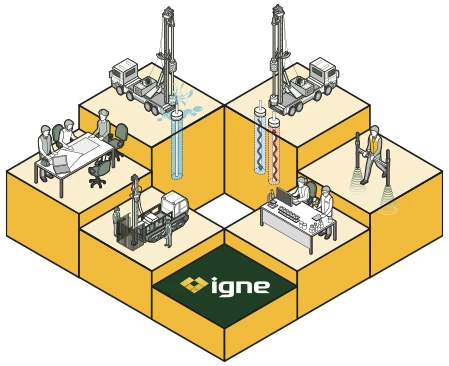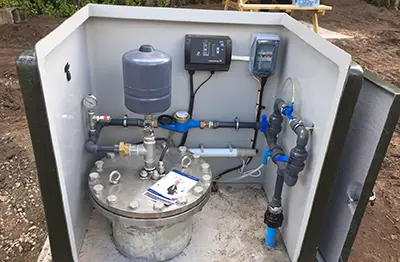

Natural Gamma Radiation Logging
Natural gamma radiation logging is a key borehole geophysical technique used to measure the natural radioactivity of subsurface materials.
About
Gamma Logging
This non-invasive method helps to distinguish between different rock types, identify clay-rich zones and correlate lithological formations across a site or project area.
At Igne, we provide accurate, high-resolution natural gamma logs as part of our borehole geophysics service offering. Whether you're assessing aquifer potential, refining a ground model, or validating core recovery, gamma logging adds valuable context and depth to your understanding of the ground.

The purpose
What Does Natural Gamma Radiation Logging Measure?
Natural gamma logging records radiation emitted naturally by isotopes such as potassium-40, thorium, and uranium within the borehole walls and surrounding formation.
These elements tend to be more concentrated in clay and shale layers than in clean sands, gravels or carbonate rocks, making gamma logs highly effective for:
- Lithology identification and correlation
- Locating clay horizons or interbedded sequences
- Mapping changes in formation consistency
- Assisting with screen or casing placement in wells
- Correlating borehole logs with geological mapping or core logs
- Providing data in uncored or poorly recovered sections
The uses
Applications Across Sectors
Natural gamma radiation logging is widely used across water, energy, infrastructure and environmental projects. At Igne, we apply this technique to support:
- Aquifer characterisation for water boreholes
- Geotechnical investigations
- Contaminated land assessments
- Geothermal design optimisation
- Environmental baseline studies
- Long-term monitoring programmes
It's especially useful in open-hole conditions or where minimal disturbance is required.
The Process
How It Works
A gamma probe is lowered into the borehole and continuously records the gamma radiation as it descends and ascends. The data is logged digitally and plotted as a curve, typically in counts per second (cps), showing variations in natural radioactivity with depth. Natural gamma can also be provided in calibrated API format if required.
It works by using a scintillating gamma crystal, which converts natural gamma rays into light, which can be used to measure gamma intensity. This is then converted into a well log, by the surface unit, which is transmitted to the laptop.
Natural gamma is typically stacked with a 3 Arm Caliper, and the data acquired simultaneously as the first logging run. This gives our technicians an idea of the borehole condition, and a rough lithological profile.
These variations are then interpreted to understand the distribution of clays, silts and other fine-grained materials, helping to define geological boundaries and inform next steps in drilling, sampling or installation.
FAQ
Frequently Asked Questions about Natural Gamma Radiation Logging
- Does the borehole need to be open or cased for gamma logging?
Gamma logging can be performed in both open and PVC-cased boreholes. Metal casing, however, will attenuate the readings and will be significantly less effective.
- Is the process safe?
Yes, the tool measures naturally occurring radiation - it does not emit radiation. It’s a passive, safe method with no health or environmental risk.
- What depth range is possible with your gamma logging equipment?
We can log boreholes to several hundred metres, depending on access and borehole stability. We’ll confirm this during project planning.
- Is gamma logging useful if core samples are already available?
Yes; gamma logs help correlate between core data and non-cored intervals, and assist with checking the consistency of recovered material. It can also be used to correlate depth with televiewer runs, if there are any discrepancies.
- How quickly is the data available?
Preliminary logs can often be reviewed on site. Final reports and plotted logs are typically provided within a few working days.
The next step
Your expert gamma logging partner
When you need to understand what’s going on below ground, Igne’s gamma logging service delivers dependable data you can build on.
Get in touch today to discuss borehole logging options, and to find out how natural gamma ray logging could support your next project.


Temperature & Conductivity Logging

Flowmeter Logging

Caliper Measurement Logging

Dual Focused Resistivity Logging

